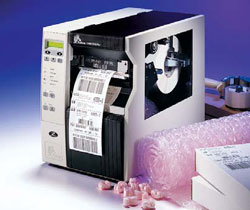How to Get Started with Barcoding
 When you’re looking to get started with barcoding, it’s easy to get overwhelmed by the many available options.
When you’re looking to get started with barcoding, it’s easy to get overwhelmed by the many available options.
In this article, we provide simple and easy advice to avoid the confusion and help you quickly determine the right barcoding approach for your business.
On-Demand vs. Pre-Printed Labels
The first critical decision for barcoding is whether to invest in a barcoding system or purchase pre-printed barcode labels.
Pre-printed labels are useful in operations that require only a low volume of identical labels with fixed, non-variable data.
However, if you need to include variable information or data on each label, or you need to combine both text and barcodes, you’ll probably need to invest in a barcoding system. This system will include a printer, labels, and supplies so you can produce customized labels on demand.
Barcode Printing Technologies
If you need to invest in a barcoding system and print your own custom labels, you’ll need to determine the right printing technology to use.
Companies new to barcoding often gravitate toward familiar printing technologies such as laser, dot matrix, or ink jet printers. But these offer limited print speed and flexibility and usually don’t print labels durable enough for anything other than the most basic barcoding applications.
This is why direct thermal and thermal transfer printing are the most widely used print technologies for barcoding. Both methods use a heated printhead to create an image on a label, and they’re designed to meet enterprise-grade barcoding requirements.
Typically, direct thermal or thermal transfer will be used when labels need to be printed on demand with high-definition barcodes and when applications require variable data, durability, varying label sizes, or graphics and scalable text font sizes.
Direct thermal printing is ideal for applications where a label doesn’t need to last very long. Shipping labels and receipts are two common uses.
Direct thermal printers don’t use ink, toner, or ribbon, so they’re simpler to operate and don’t require supplies other than the material to be printed. Consequently, costs are lower as well.
However, direct thermal labels are extremely sensitive to environmental conditions such as temperature, light, chemicals, and abrasion. Because direct thermal paper remains chemically active after printing, thermal labels, tags, or other media are often top-coated to resist UV light exposure, chemicals, and abrasion. The top-coat helps make labels more resistant to heat and cold conditions as well.
Thermal transfer printing is matched with suitable media to create crisp, high-definition text, graphics, and barcodes for maximum readability, scannability, and resistance to heat, moisture, abrasion, rubbing, and chemicals.
Thermal transfer printers require a ribbon, so there’s a higher supplies cost. But thermal transfer printheads last longer than direct thermal printheads, which adds up to significant savings.
When using thermal transfer, the ribbon and label media must be compatible and carefully selected to avoid causing internal printer problems.
Choosing the Right Printer & Supplies
There are a number of major brands of barcode printers and supplies, but our barcoding experts at Tri-State Business Systems always recommend Zebra printing solutions.
Zebra is the barcoding industry’s undisputed leader in reliable, high-performance barcode printers and pre-tested, high quality supplies. From small, compact desktop or mobile printers to ultra-rugged industrial printers, Zebra’s devices offer the best quality at the lowest long-term cost.
Zebra is also unrivaled in its supplies selection and quality, with over 500 stock options and over 1,000 combinations of labels, ribbons, tags, and more.
Getting Expert Recommendations
If you’d like to make sure you make the right choices for your business, contact our team for a free consultation. Call Tri-State Business Systems at 908-359-8001 or email us now.
